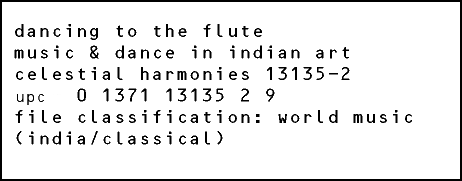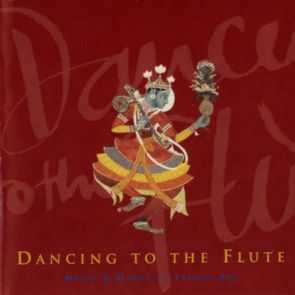 |
|||||||||||||||||||||||||||
 
Mythologie, Spiritualität und Musik sind in der indischen Kultur eine Einheit. In den ältesten Schriften, den Veden, gilt der heilige Klang OM als Symbol für Brahman, für das Allumfassende. Die Rishis (Seher) singen OM, spüren die Essenz im Inneren und verbinden sich so mit dem Höchsten. Geht man heute durch eine Strasse in Bombay oder Varanasi, kann man aus einem Hindutempel die dreitönigen, rhythmisch skandierten vedischen Gesänge, aus dem Plattenladen einen Raga von Ravi Shankar, aus einem vorbeifahrenden Auto Bollywood-Sentimentals und auf dem Fußgängerweg neben einer Abfall fressenden Kuh den Bettler auf der einsaitigen Veena hören. Für die meisten Inder ist das alles immer noch heilig - Gott singt. Zugleich ist kaum eine Musikerausbildung strenger als die zum Ragavirtuosen. Wer öffentlich einen Raga aufführt, kommt in der Regel aus einer alten Musikerfamilie, ist wenigstens vom 6. Lebensjahr an bei einem Guru (oft dem eigenen Vater oder Großvater) in die Lehre gegangen und hat 10 - 20 Jahre acht Stunden täglich geübt, auch geistig und spirituell. Wer indische Musiker live erlebt hat, wird sich vielleicht gewundert haben, wie entspannt und lustig die dabei sind. In Varanasi (Benares) sterben - das ist der Traum jedes Hindus. Die heiligste (und für Westler vielleicht irritierendste) Stadt Indiens am Ganges wählte Produzent David Parsons ganz bewusst für diese Aufnahmen. Die (innere) Reise beginnt mit OM. Vedischer Gesang - das Gayatri Mantra - zum satten Grundtonklang der Tambura, dazu Glocken, Zymbeln, das Streichinstrument Saranghi. Gelungener Einstieg in das alte, zeitlose Indien. Dann Shiva: Trommel (pakhavaj solo), komplexe Rhythmik, Tanz, dem Erhalter und Zerstörer gewidmet. Krishna verführt mit seinem Flötenspiel, klassischer Raga Kausikdhwani, lieblich, unwiderstehlich. Und so geht es weiter über devotionale Gesänge, Ragas und Volksmusik. Ursprünglich für eine Ausstellung indischer Kunst in Sydney zusammengestellt, ist diese Compilation eine der besten Einführungen in indische Musik überhaupt. the projectDesigned and recorded for the Music & Dance in Indian Art exhibition at The Art Gallery of New South Wales in Sydney, Australia (winter 1997), Dancing to the Flute is the most beautiful music of India, exquisitely capturing its musical heritage. Recorded on location in Varanasi (Benares), the most sacred city in the country and home to some of the greatest musicians in India, Parsons embarked on his typically challenging adventure in accomplishing such a remarkable audio documentation. From locating a reliable electricity source, repairing machinery with seemingly non–existent resources to calibrating the fundamental pitch for all instruments since all tracks would be played simultaneously at the exhibition, he and the musicians overcame all obstacles. This Indian musical odyssey begins with Om featuring tamburas—a four–stringed drone instrument—considered the mother of all musical instruments. Track 2, a dedication to Lord Shiva features the pakhwaj—a percussion instrument predating the commonly known tabla. Track 3, represents Lord Krishna and features one of the most ancient Indian instruments, the bansuri or Indian bamboo flute. Track 4 features solo voice in dhrupad (classical) style with tamburas representing the Celestials, or all other forms of god in the Hindu pantheon. Tracks 5 and 6 are worship and devotional songs featuring both North and South Indian styles. Folk Medley is folk and tribal music featuring the shehnai—a double reed wind instrument with a brass bell attached to the end like that of a small trumpet, accompanied by dukka—a pair of drums similar to tabla, and drones. Completing this documentation of Indian music is the sound of the most well known Indian instrument in the West, the sitar, in the Ragamala form consisting, in this case of Misra Khamaj (Misra meaning mixed), with touches of other ragas introduced according to how the artist is inspired at the time. the artistsRenowned New Zealand producer/musician/composer David Parsons has created a timeless keepsake of Indian music featuring the leading musicians of today's India. Shri Kant Mishra (Toon Maharaj) is a master of the art of pakhwaj and India's leading pakhwaj player. Dr. Ritwik Sanyal, a lecturer in vocal music at the Banaras Hindu University, is a well known singer of the dhrupad style of North Indian classical music. Dr. C.R. Jyotishi, professor and head of the Department of Vocal Music and Dean of the Faculty of Performing Arts, Banaras Hindu University, is a specialist in all forms of North Indian singing including khayal, bhajan (religious), thumri (light classical) and dhrupad. Ramashankar belongs to a traditional school of Varanasi shehnai players and is well known as a virtuoso of the shehnai and the flute. K. Sashikumar, a lecturer in Karnatak (South Indian) music in the Department of Vocal Music, Faculty of Performing Arts, Banaras Hindu University, is a well known singer of South Indian classical music. Dr. Krishna Chakravarty, one of the best sitarists in India, studied sitar from a very young age under Professor Ram Chakravarty and later under Pt. Ravi Shankar. She can also be heard on her solo recording Ananda (17046) and Circular Dance (13133). Vinod Gangadhar Lele is a master of the tabla. He studied tabla under Pt.Kashinath Khandekar of the Banaras gharana (school). Support artists include: Ustad Nazim Ali Khan, sarangi; Ramji, dukka; Vijayshankar, shehnai drone; and David Parsons, additional tamburas. tracklist
|
|||||||||||||||||||||||||||
|
|
|||||||||||||||||||||||||||
 |


